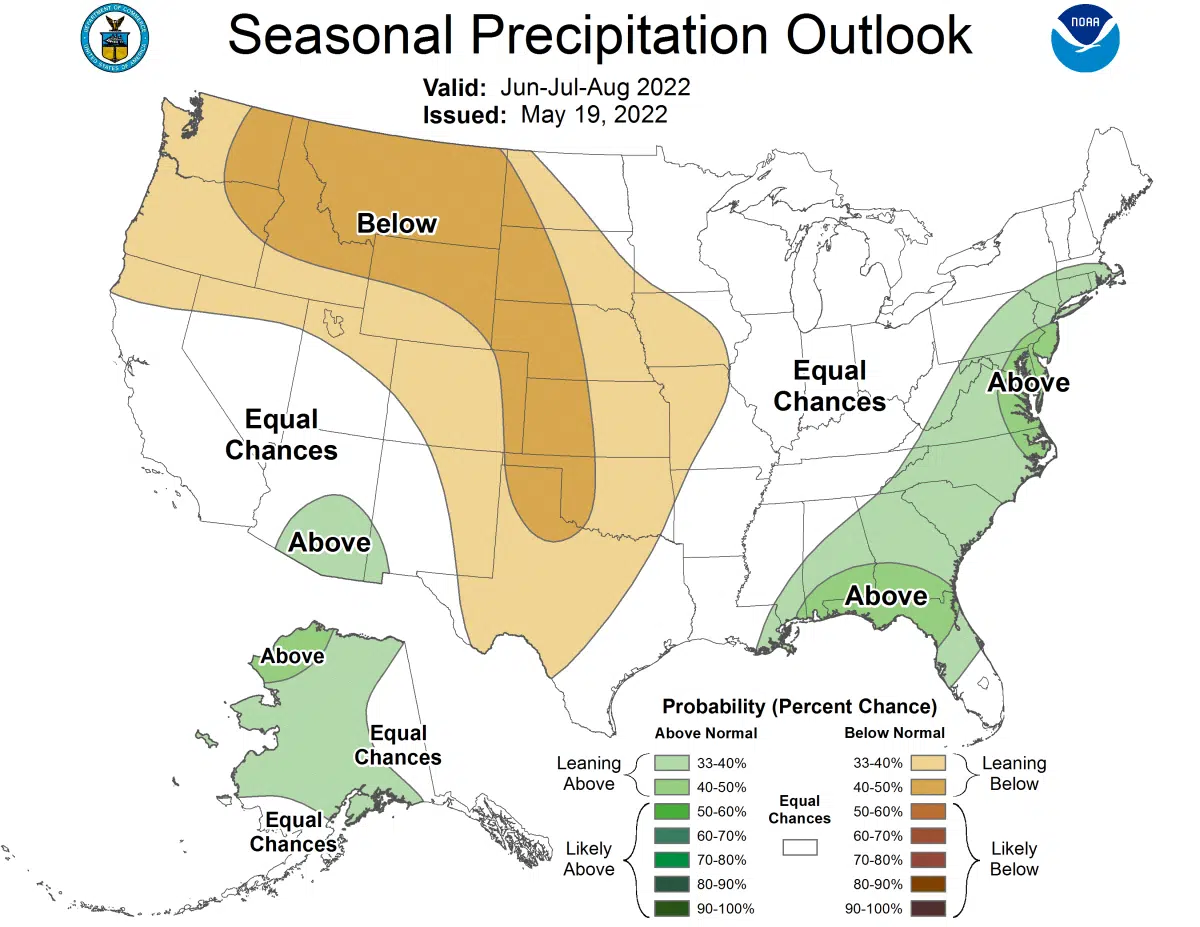The summer season climate outlook continues to favor warmer and drier conditions for most of South Dakota, according to the NOAA’s Climate Prediction Center.
On May 19, the NOAA’s Climate Prediction Center released their temperature and precipitation outlooks for June and the summer season ahead. For the month of June, the southern half of the state has slightly enhanced chances of warmer-than-average temperatures. This outlook would provide an ending to a cool spring season, even though the month of May has been slightly warmer than average.
The precipitation outlook for June leans towards drier-than-average conditions in the southwest corner of South Dakota. All other areas have equal chances of wetter, drier or near-average moisture in the month of June. The area that is favored to be drier than average includes a region that is already in moderate drought, according to the U.S. Drought Monitor that was also released on May 19, 2022. The combination of warm and dry conditions in June, in what is typically one of the wettest months of the year, could likely lead to continuation or worsening drought in this region.

Precipitation outlook for June through August 2022. Tan shaded areas indicate increased chances for drier than average. Courtesy: NOAA Climate Prediction Center.
Summer 2022 Outlook
For the summer months of June through August, the likelihood of warmer-than-average temperature increases and covers the entire state of South Dakota. This is consistent with what climate models and forecasters have been predicting for months—that most of the lower-48 states are more likely to have warmer-than-average summer temperatures, as compared to cooler or near-average temperatures. Warmth in the summer could allow late-planted crops to catch up for lost time by accumulating some growing degree days faster than usual in the next few months.
Summer season precipitation continues to lean towards drier-than-average conditions for all of South Dakota, except for the far northeast. The state is included in a large region, from the Pacific Northwest through the Central Plains, that is favored to have drier-than-average conditions. This pattern has been consistent in the climate models and forecasts for the last few months. June and early July precipitation is critical for our current drought-stricken areas, as chances of precipitation gradually lower after that time. Dry conditions can be made worse with warmth, which has not been a factor yet this season, but appears to be on the horizon. There is some concern that some of the recent improvements in drought conditions in central South Dakota and other areas could be undone by the warmer and drier climate pattern that appears to be setting up for the summer season.
One area of the state that has had too much moisture is the northeast. This region is currently in equal chances of wetter, drier or near average precipitation for June through August. With saturated soils already a problem, the outlook does not necessarily provide for dry-down. Using a glass half-full analogy, this also could be interpreted as a potential for good crop growing conditions this summer with sufficient moisture and warmer temperatures making up for the loss of some growing degree days early this spring.
La Niña is a factor in the warm and dry pattern this season, for the second year in a row. This is a very unusual situation, as long-range outlooks are projecting a possible continuation of La Niña for a third winter in a row. This has only occurred about three times in our observed history of El Niño and La Niña since 1950.
For those who are in drought or in near-normal or borderline drought conditions, now is the time to make a plan in the event that conditions dry out. For ranchers, this may include planning for alternative feeds or grazing, considering water sources and being sure to test water before turning cattle out to pastures, starting or increasing monitoring of your grazing lands to ensure adequate forage for animals, and looking at financial impacts of some alternatives, or finding some cost-share program to provide good water or other infrastructure (like fencing).
For gardeners and homeowners, plan your garden plantings so that you can water your ornamentals, fruit and vegetable plants in the summer. This may mean installing drip irrigation or laying out your garden so that you can set up a sprinkler or other watering system later in the season if heat and drought become a problem. A little planning now can pay off in reducing your stress and workload in the mid-summer season.








Comments